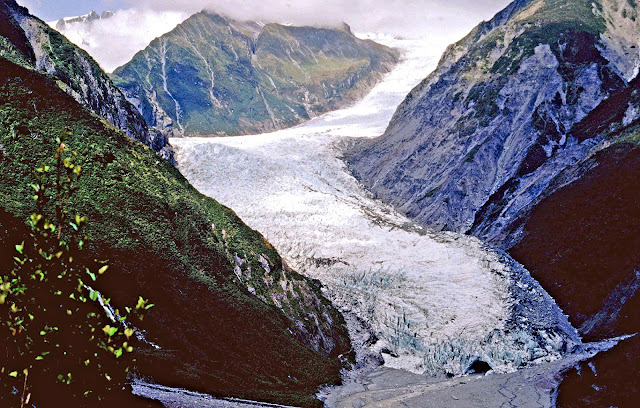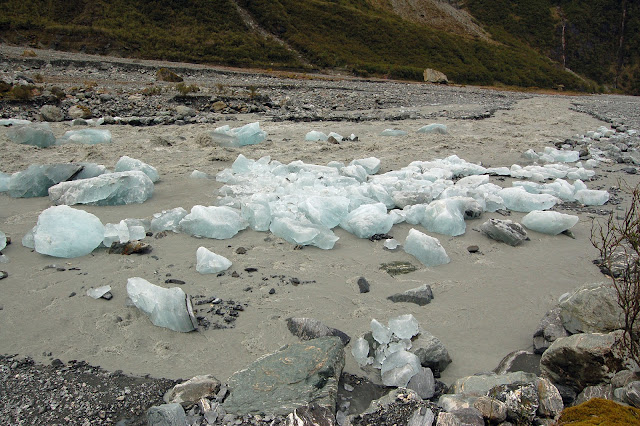Tumbling down from the vast névés of New Zealand's Southern Alps, flow great rivers of ice, dropping over a short distance from the snowfields of over 10,000 feet into the temperate rain forest of the South Island of New Zealand's West Coast. The two mightiest of these remaining glaciers are the Franz Josef and the Fox.
During the 1990s and the early 2000s, contrary to what was happening elsewhere in the world, these two glaciers were, in the main, advancing, at times quite rapidly. I was leading adventures in New Zealand at the time, and we included a Glacier hike on the Fox Glacier as part of our tour itinerary. It was an exciting time, as each tour would see changes to the Glacier and the access route to the ice would have changed. On one tour we would climb up the snout of the glacier and on the next, we would scramble over the rocky, rubble-strewn lateral moraine. At the height of the advance, we would hike up through the temperate rain forest before dropping down onto the ice. It was always a great experience.
Over the years I took many photos and have included a few of these in this photographic essay.
A warning sign denoted the beginning of the access tracks to the ice, which many individuals seemed to ignore.
It was a unique experience to walk through rain forest to access this great river of ice.
The access point was where the glacial ice came close to the crumbling rocks of the lateral glacial moraine. Due to the fragile nature of the terrain caused by the movement of the glacier, this would change each time I brought a group here.
Once on the Glacier the route would change each time. There were ice pinnacles known as seracs, to pass around.
Sometimes we could get quite close to the ice pinnacles, but we always had to beware of falling ice.
The Glacier guides would cut steps into the hard glacial ice on the steeper section of the route, making access for groups easier, and lessening the risk of slipping. A guide would always be on the ice, surveying the new days route, and maintaining the previous day's stairs if they were to be used.
If we were lucky we would find an ice cave to walk through. These ice caves were not that common on the area of glaciers that we walked.
Near the edge of the ice, curious denizens of the rain forest, such as the friendly little South Island tomtit, would watch us.
As we walked over the ice, low clouds, on most days, would wreath the mountain peaks above Fox Glacier.
On some hikes, our route would take us to an icy high point which overlooked the Valley of the Fox River, carved out of the mountains by successive ice ages.
Small ice pinnacles and shattered rock will soon tumble down into the Fox River.
The waters of the Fox River emerge from a ice cave at the snout of the Glacier. Occasionally, an ice collapse would cause a blockage in the Cave, and after pressure built up, usually after heavy rain, the ice would blow out down the valley, a good reason not to go near the ice cave.
In December 2007, the Fox Glacier still looked spectacular, even from the access track, but from this time the Glacier began retreating rapidly, as the effects of global warming take effect.
Text & photographs ©Neil Rawlins Selected travel photos from these & other blogs are available from my photo gallery |
My paperback books on my Overland travels in Asia, Europe & Africa in the early 1970s and the experiences of a tour guide on the Asian Overland routes & leading Camel Safaris in Rajasthan in the 1980s are available from Amazon.




















Thanks for sharing these wonderful images.
ReplyDeleteCab Service in India!
Taxi Service in india!